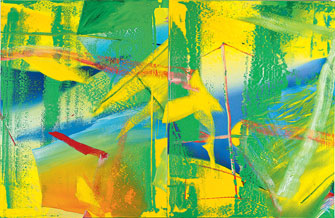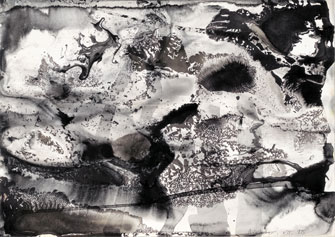Ode to Joy
From Greatest Living Artist

Gerhard Richter’s “Yellow-Green” (1982), © Gerhard Richter, 2012
Gerhard Richter, born in Dresden in 1932, has been toiling away at his paintings, photographs and installations for 50 years now, but it is only in the past decade or so that a consensus seems to have quietly formed that he is today’s greatest living artist.
The important thing to know about Richter is that, unlike most other artists, who would rather stick to a style and build their identity on it (and not risk criticism by being inconsistent), he moves with complete indifference from figural to abstract art and back again, doing what feels right to him for a particular project.
It is already a bit late in the game to be discovering his work, since many of his great paintings have already been snapped up by private collectors, and their value will only go up from now on, making it harder for museums to collect his work, but “Gerhard Richter: Panorama,” an exhibition planned by the artist himself in three slightly different versions and traveling from London to Paris to Berlin, is now at the Centre Pompidou, while a wonderful exhibition of his drawings is running concurrently at the Louvre.
The next important thing to know is that his abstract paintings are gorgeous, luscious, unabashedly beautiful and complex pictures. Richter, that highly tolerant artist, doesn’t even mind if you read into his works whatever images you want to see in them – heresy to most abstractionists – “because everything is rooted in the world; everything relates in some way to the world and experience.” Case in point: the shimmering surface of one of the paintings in the Pompidou show, “Forest (3),” reminded me of – gasp! – Monet’s waterlily paintings, just as gorgeous but deeper, more powerful and less pretty.
All of Richter’s abstract works boast that intensity, not just those in sumptuous colors, applied in thick layers over long periods of time and then squeegeed away selectively to reveal buried colors underneath—a technique that creates a thick, lush surface—but also those in pale, delicate colors or even grays. (By the way, have I mentioned that Richter has an incredible color sense?) You can stand and look at his abstract paintings for a long, long time and still feel interested and even excited.
Next to them, his photo-based paintings are far less impressive. He has returned to these many times since the beginning of his career, making a gray painting based on a photo then running a squeegee over it to give it a slightly blurred effect. What’s the point? Richter also likes to play around with installations made of sheets of glass or mirrors. Some of these are effective as you walk around them, their reflections and transparency forming a solid yet insubstantial geometric shape.
There are also some very pretty traditional landscapes in the show. Richter defends his right to be pretty, too, and claims that he see landscapes as abstracts, but, again, I say, what’s the point? For me, his originality and the fascination of his work lie almost exclusively in his abstract painting. The rest is interesting but no more. When it comes to abstraction, he’s a genius.
Needless to say, do not miss this show or the exhibition of his drawings at the Louvre. On

Richter’s “7.1991” (1991).© ADAGP © Kunstmuseum Winterthur
paper, too, he has that ability to make a simple abstract image complex and beautiful.
Centre Pompidou: 19, rue Beaubourg, 75004 Paris. Tel.: 01 44 78 12 33. Open 11am-9pm. Closed Tuesday. Métro: Rambuteau. Admission: €12. Through September 24. www.centrepompidou.fr
Musée du Louvre: Hall Napoléon. Métro: Palais-Royal-Musée du Louvre. Open Wednesday-Monday, 9am-6pm (until 10pm on Wednesday and Friday). Closed Tuesday. Admission: €11.00. Through September 17. www.louvre.fr
Reader Terry Seligman writes: “Your question ‘What’s the point?’ (referring to Richter’s blur paintings) begs other queries: Where is the place where painting and photography meet? How can we tell if history is true? And more….
“When I think about most artists, I flash on a particular style. Richter is just about the only artist I know of who pops into my head with multiple differing styles, all of them perfectly realized.
“Can’t wait to see this exhibition.”
Reader Reaction: Click here to respond to this article (your response may be published on this page and is subject to editing).
Please support Paris Update by ordering books from Paris Update’s Amazon store at no extra cost. Click on your preferred Amazon location: U.K., France, U.S.
More reviews of Paris art shows.
© 2012 Paris Update
